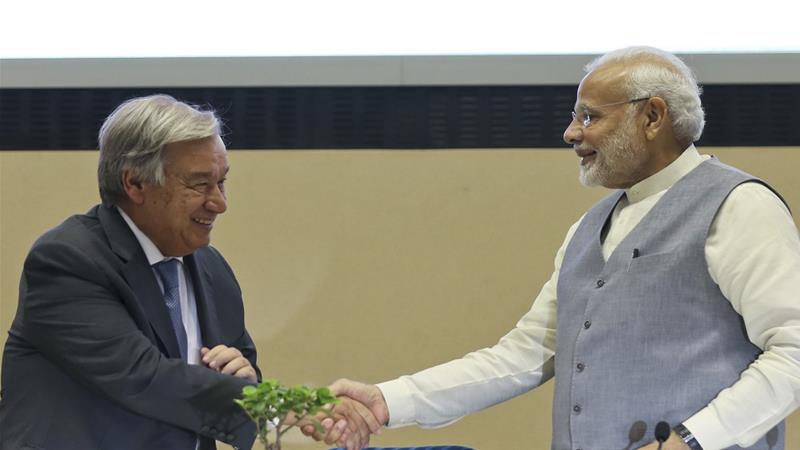Will India take centerstage at what has become the centrepiece of 2019 climate agenda – the UN Secretary General’s Climate Action Summit in New York on September 23. The world’s third largest emitter of greenhouse gases, India certainly fits the role as it is poised to overshoot its Paris commitments, and therefore has room to upgrade targets. Which is also the key demand of the UN chief António Guterres, the convenor of the critical summit. Last weekend Guterres wrote to each head of state pushing them to chalk out “concrete plans” to achieve carbon neutrality by 2050. He demanded a brief summary of the plans to be submitted by August 7.
UN Special Envoy on Climate change Luis Alfonso De Alba has been in Delhi for the last two days meeting with Indian ministers and business leaders. He told the press that 28 companies with a market cap of over $1.3 trillion have committed to science-based targets in line with 1.5C scenario. He announced a new ‘Clean Air Initiative” calling on national and local governments to commit to align climate change and policies to fight air pollution by 2030.
These targets are not daunting for India, considering it is projected to achieve its Paris clean energy goal a decade ahead of 2030. Even though it plans to carry on using coal energy, it has cancelled and shelved over 573GW worth of coal power plants over the last 10 years. Currently, India’s renewable capacity stands at 124.6 GW, including power generated from large hydropower projects, according to the country’s Ministry of Power.
This accounts for about 35% of India’s current installed capacity of 357 GW. The government has ambitious plans to increase solar and wind capacity from the current 77 GW to 175 GW by 2022, and then further to 260 GW by 2024. So if all goes to plan, India is expected to achieve its Paris target of 40% non-fossil fuel energy capacity by mid-2020s, years ahead of the 2030 timeline mentioned in India’s Nationally Determined Contributions (NDC).
India’s Central Electricity Authority (CEA), under its Optimal Energy Mix scenario for 2030 says India will have around 523GW of renewables (solar, wind, small & large hydro, biomass) and 291GW of thermal capacity. This means, 63% of the total installed capacity would be from non-fossil fuel sources. According to IEEFA analysis based on CEA projections, this translates to overachieving the clean energy goal, one of the three Paris agreement targets, by 60%.
“I am aware that India has achieved a lot and it may surpass its Paris agreement targets. I hope that this will translate into enhanced NDC. That is a decision Indian Govt should take in the coming days… (India is) aware that more needs to be done on agriculture, air quality and other issues. I think there is a commitment from the Indian govt. to increase,” said UN Special Envoy on Climate Change – Luis Alfonso De Alba. The UN’s hopeful optimism on India’s stance regarding enhancing ambitions comes as little surprise. Being the world’s third largest emitter behind China and the US, India’s direction on climate action is seen as crucial for any chance of success in limiting global warming and climate change.
But climate diplomacy isn’t the only reason for India to display proactiveness in its climate and energy policies. In fact, India’s urgency in shifting to renewables is to a large extent a matter of necessity rather than choice. According to government think tank NITI Aayog, India’s primary energy demand is growing by 4.3% year-on-year and will almost triple between 2015 and 2040. The thousands of lost lives and billions of dollars of economic losses attributed to extreme weather each year in the country already routinely exposes India’s vulnerability to climate impacts. With an almost certain escalation of such impacts on the cards, India has little choice but to look beyond coal to fuel its growing energy demand.
Good planning would require a priority for carbon-neutrality and a move towards cleaner sources of energy, says CDP directorDamandeep Singh. “It is essential that the Indian economy provides an ambitious and viable pathway to a net-zero carbon economy by 2050, to become an example for other rapidly developing economies to emulate.”
There is agreement on this point- Climate action and carbon reduction pathways must be integrated India’s development priorities. “Over the last ten years India’s renewable capacity has increased over 150%. To move towards a $5 trillion economy India needs to ensure that new growth is powered by clean energy. There is an understanding now that low carbon pathways will have to be germane for India’s development story. As a country on the frontline of climate impacts and showing good signs of climate progress, it is in our own interest to accelerate the transition to a clean future,” says Arunabha Ghosh, CEO, Council on Energy Environment and Water CEEW
The Special Envoy’s visit to the sub-continent comes days after UN Secretary General Antonio Guterres said he had “asked all leaders to come to the Summit ready to announce the plans that they will set next year to reduce greenhouse gas emissions for 2030 and to achieve net zero emissions by 2050.” India has thus far held its cards close to the chest- trying to balance its energy mix even as demand rises continually.
Amid China refusing to offer much clarity on any plans for carbon neutrality, US’ stubborn antagonism towards climate action, and the EU’s internal disagreements on coal, India’s careful tightrope walk is garnering some serious consideration for the country to be viewed as a climate leader with intergovernmental talks set to intensify over the coming months.
About The Author
You may also like
Companies in BASIC nations are turning carbon rules into an advantage: Report
Air Pollution is Changing the Lightning Patterns in India, Study Finds
Can green trade barriers save the environment?
Brazil Set 60-Day Deadline for Fossil Fuel Phase Out Plan
Temporary CO2 Removal Will Help Offset Methane Emissions: Report

